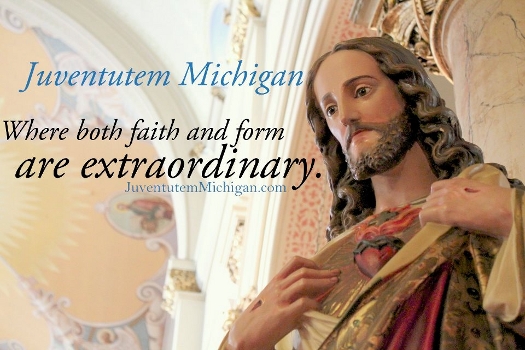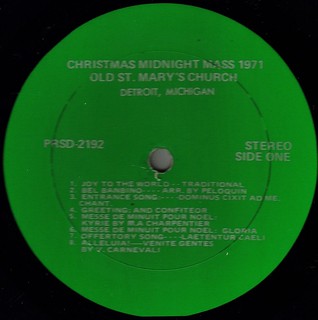
"I will go in unto the Altar of God
To God, Who giveth joy to my youth"
Tridentine Community News (June 9, 2013):

The Pontifical University of St. Anselmo in Rome has announced that it will be offering a two-year Master’s Degree program in Gregorian Chant and the use of the organ at Mass. St. Anselmo is a Benedictine University known, along with its affiliated parish church, as a center of liturgical scholarship.
This may very well be the first such Master’s program in modern times. The curriculum is being headed by Fr. Jordi Piqué from the Benedictine Abbey of Montserrat, Spain. He was quoted as saying that use of Gregorian Chant is increasing, presumably creating a need for such an academic offering. Gianfranco Cardinal Ravasi, the president of the Pontifical Council for Culture, will be one of the guest lecturers. St. Anselmo is also offering an intensive summer course in Latin. Considering that St. Anselmo has not always been known for traditional leanings, these are welcome developments, indeed...yet another sign of the recovery of liturgical traditions in our age. The Way of Beauty The Way of Beauty is a recurring column authored by Sr. Joan L. Roccasalvo, C.S.J. for CNA, the Catholic News Agency. It can be read on their web site, www.catholicnewsagency.com. The byline of the column states that Sister “writes with a particular focus on a theology of beauty and the sacred arts.” She addresses a number of interesting topics and regularly articulates the roles that Latin and Sacred Tradition should play. A recent excerpt gives a sense of the content readers will find:“With the renewed ecclesiology of Vatican II, it might have been wiser to make the necessary correction from within the tradition instead of admitting foreign elements that did not emerge organically from the tradition. It might have been wiser to adapt some chants to English and rediscover the chant in a new context. Many had hoped that, by singing in a popular style, active participation would elevate liturgical worship, thus making it a beautiful experience. We have learned otherwise. Such is the wisdom of hindsight.”Columns address a spectrum of subjects, such as how the Church is actually the Patron of Science, in contrast to assertions frequently propagated by the secular media. A series was entitled, Rebuilding Catholic Culture, with individual columns subtitled Church Architecture and Sacred Images. Another recent column, How the Church Built Western Sacred Music, gave a concise history of what the Church believes is the proper music for the Sacred Liturgy, and how evolution of Catholic music has bifurcated in recent decades into good and bad artistic threads.
Sister lets readers know about some fascinating initiatives, such as the National Catholic Youth Choir Summer Camp at St. John’s Abbey in Collegeville, Minnesota – an intensive exposure for youth to the Church’s authentic repertoire, somewhat analogous to Michigan’s Interlochen Summer Arts Camp.
Sister Roccasalvo has an excellent skill for communicating the utter logic and sensibility of the Church’s teaching. Ecclesiastical or secular, the best sales pitches are the ones that appeal to common sense: As long as we can explain our Faith clearly and compellingly to others, converts will be easier to gain. In that sense, her column series is instructive both for its approach and argumentation style as well as for its substance.
Local Latin Liturgical History: Singing the Propers is Not a New Thing
Readers who frequent the Tridentine Mass know that chanting the Propers of the Mass (Introit, Offertory, and Communion Antiphon) is standard practice in a High Mass. With the recent publication of books such as Simple English Propers and The Vatican II Hymnal, there has been a surge in popularity in singing the Propers in the Ordinary Form as well, whether in Latin or in English.
Or should we say a resurgence: The Recordo Obscura blog has posted a recording of the 1971 LP, Midnight Mass at Old St. Mary’s, featuring Charpentier’s Messe de Minuit de Noel, the choir being led by then-music director, now-Father, Eduard Perrone. This 41 year old recording of an Ordinary Form Latin Mass includes...chanted Propers.
Indeed, Detroit’s Old St. Mary’s for many years even chanted the Gregorian Gradual in place of the more commonly-heard Responsorial Psalm, a permissible but rarely heard option in the post-Vatican II Mass. Decades before it became popular, one of our longstanding local homes of [Ordinary Form] Latin liturgy was doing what was...proper.
Tridentine Masses This Coming Week
- Mon. 06/10 7:00 PM: Low Mass at St. Josaphat (St. Margaret of Scotland, Widow)
- Tue. 06/11 7:00 PM: High Mass at Assumption-Windsor (St. Barnabas, Apostle)




No comments:
Post a Comment